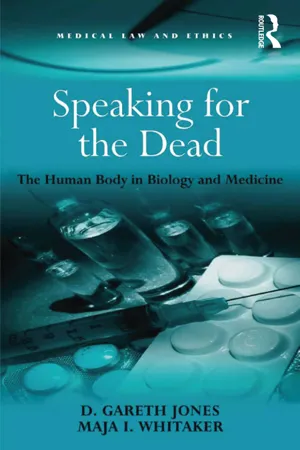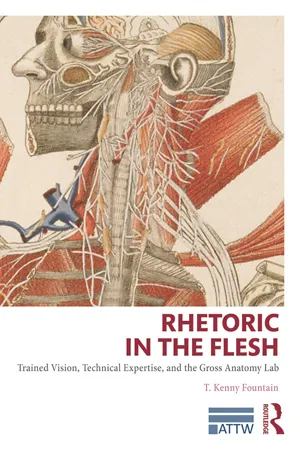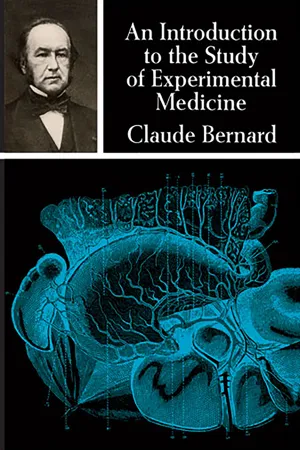Biological Sciences
Dissection
Dissection is the process of cutting and separating tissues or organs of an organism to study its internal structure and functions. It is commonly used in biological sciences to understand the anatomy and physiology of living organisms. Dissection can be performed on both plants and animals.
Written by Perlego with AI-assistance
Related key terms
3 Key excerpts on "Dissection"
- eBook - ePub
Speaking for the Dead
The Human Body in Biology and Medicine
- D. Gareth Jones, Maja I. Whitaker(Authors)
- 2016(Publication Date)
- Routledge(Publisher)
raison d’être is the structure of the human body. This is particularly the case for teaching, in which Dissection of the human body constitutes a central activity. For medical students in particular, anatomy is largely defined as what can be learned from Dissection of the human body. Gross anatomy, with its Dissection and macroscopic study of the regions and systems of the human body, is the closest we come to a public image of anatomy, regardless of how members of an anatomy department may view the scope of their discipline. Anatomy, in this sense, is replete with nineteenth-century connotations that sit uneasily alongside the activities conducted in many contemporary anatomy departments.It is impossible to move beyond this elementary point without enquiring into the culture of Dissection, with its roots in the sixteenth and seventeenth centuries. No matter how anatomy is defined in the twenty-first century, there is no debate as to its position within the spectrum of academic disciplines: it is a biological science. What debate there is, concerns whether it belongs mainly within the domain of medicine, as a science serving medical education, or as one of the biomedical sciences.In other words, were we to use the verb ‘anatomize’ or the noun ‘anatomization’ today, we would use it in a scientific sense. When a body is anatomized, or dissected, a complete body is reduced to its component parts in an attempt to build up a new body of knowledge. More specifically, the body of one individual is dissected so that a profession’s understanding of the morphology and function of bodies in general can be increased. In the light of that which is learned about specific bodies, the intention is to strengthen and broaden the science of anatomy in general.But what do we mean by such an obvious term as ‘the body’? According to Kass (1985), the term in Old English referred to the living body, and only later in Middle English was the same term used for the dead body or corpse. Later, it was used to refer to the person or individual being. - eBook - ePub
Rhetoric in the Flesh
Trained Vision, Technical Expertise, and the Gross Anatomy Lab
- T. Kenny Fountain(Author)
- 2014(Publication Date)
- Routledge(Publisher)
Students in the Dissection course and TAs in the prosection course describe this mutual relationship of revealing and learning as being “lost” in the body. First, they get lost in the sense of having lost their way and feeling confused about how, what, and where to cut. Second, they lose themselves by becoming intellectually absorbed in the process of dissecting. In the first case, the losing of one’s way, participants rely on instructors, TAs, or students to step in and begin identification, for example by calling out structures as a wayfinding aid. This collaborative element of Dissection, working in teams to find and identify structures, supplements the use of multimodal displays when the cadaver’s physical body resists a simple rendering or when there is little resemblance between the body and the display. As the course instructor makes plain, both cases common:Dissecting is a process of learning to reveal that simultaneously allows participants to create the anatomical body by learning to recognize it in the unruly flesh of the cadaver.[The structure in the cadaveric body] often looks nothing like it does in Netter. Netter is not that helpful then. It is a nice conceptual idea, but once you get in there [in the cadaver] it looks nothing like it. So you have to rely on your anatomical knowledge or someone else in the room. (Kyle, instructor of Dissection course)In the second meaning of getting “lost,” participants are lost in the revealing to learn component of Dissection, due to the intense concentration and deliberate actions dissecting requires. They need to find and identify structures in question and continue to dissect and, in a sense, perfect the cadaveric body to make those structures clear and obvious to anyone who views them. They become intellectually absorbed in their work, lost in the body, because making a structure clear and visible requires minute, detailed operations. While at times tedious, this work can be, for all participants, enjoyable. They develop manual skills and anatomical knowledge as they cut and recognize what they see, in the process gaining greater appreciation of the body’s complexity and the elegance of its physiology and relational evidence. The work of making and making clear the anatomical body for oneself connects gross anatomy students and TAs to the centuries-old practices of anatomical display. Making cadavers into idealized 3-D displays offers them the pleasures of Dissection and encourages in them an appreciation of the well-dissected body.The Aesthetics of Anatomical Dissection
Dissection is a process that makes anatomical bodies out of cadaveric one, under-stood as beautiful according to the trained vision of participants. Though not attractive in a conventional sense, participants describe dissected bodies and the processes of learning to reveal and revealing to learn in aesthetic terms. This anatomical-aesthetic sensibility is a consequence of their budding anatomical vision, the use of Netter as a model, the finished product, the process of discovery, and the experience of working closely on the body. As a product, the beautiful cadaver is made Netter - Claude Bernard(Author)
- 2012(Publication Date)
- Dover Publications(Publisher)
The scientific principle of vivisection is easy, moreover, to grasp. It is always a question of separating or altering certain parts of the living machine, so as to study them and thus to decide how they function and for what. Vivisection, considered as an analytic method of investigation of the living, includes many successive steps, for we may need to act either on organic apparatus, or on organs, or on tissue, or on the histological units themselves. In extemporized and other vivisections, we produce mutilations whose results we study by preserving the animals. At other times, vivisection is only an autopsy on the living, or a study of properties of tissues immediately after death. The various processes of analytic study of the mechanisms of life in living animals are indispensable, as we shall see, to physiology, to pathology and to therapeutics. However, it would not do to believe that vivisection in itself can constitute the whole experimental method as applied to the study of vital phenomena. Vivisection is only anatomical Dissection of the living; it is necessarily combined with all the other physico-chemical means of investigation which must be carried into the organism. Reduced to itself, vivisection would have only a limited range and in certain cases must even mislead us as to the actual role of organs. By these reservations I do not deny the usefulness or even the necessity of vivisection in the study of vital phenomena. I merely declare it insufficient. Our instruments for vivisection are indeed so coarse and our senses so imperfect that we can reach only the coarse and complex parts of an organism. Vivisection under the microscope would make much finer analysis possible, but it presents much greater difficulties and is applicable only to very small animals.But when we reach the limits of vivisection we have other means of going deeper and dealing with the elementary parts of organisms where the elementary properties of vital phenomena have their seat. We may introduce poisons into the circulation, which carry their specific action to one or another histological unit. Localized poisonings, as Fontana and J. Müller have already used them, are valuable means of physiological analysis. Poisons are veritable reagents of life, extremely delicate instruments which dissect vital units. I believe myself the first to consider the study of poisons from this point of view, for I am of the opinion that studious attention to agents which alter histological units should form the common foundation of general physiology, pathology and therapeutics. We must always, indeed, go back to the organs to find the simplest explanations of life.To sum up, Dissection is a displacing of a living organism by means of instruments and methods capable of isolating its different parts. It is easy to understand that such Dissection of the living presupposes Dissection of the dead.IV. NORMAL ANATOMY IN ITS RELATIONS WITH VIVISECTION
Anatomy is the basis necessary to all medical investigation, whether theoretical or practical. A corpse is an organism deprived of living motion, and the earliest explanation of vital phenomena was naturally sought in dead organs, just as we seek explanation of the action of a machine in motion by studying the parts of the machine at rest. It seems, therefore, that the anatomy of man ought to be the basis of physiology and human medicine. Prejudice, however, opposed Dissection of corpses, and in default of the human body, men dissected corpses of animals, in organization as close as possible to man. Thus Galen’s anatomy and physiology were done mainly on monkeys. At the same time, Galen also performed Dissections of cadavers and experiments on living animals, thus proving that he understood perfectly that Dissection of cadavers is significant only in so far as it is compared with Dissection of living bodies. In this way, anatomy is indeed only the first step in physiology. Anatomy in itself is a sterile science; its existence is justified only by the presence of living men and animals, well and sick, and by its own possible usefulness to physiology and pathology.
Learn about this page
Index pages curate the most relevant extracts from our library of academic textbooks. They’ve been created using an in-house natural language model (NLM), each adding context and meaning to key research topics.


